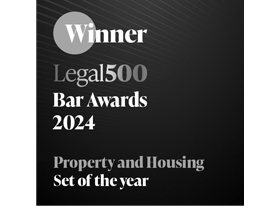Risk and Harm: Remediation Orders Through the Lens of the Housing Health and Safety Rating System 13 May 2024
- Local authorities already had powers to, in effect, require a relevant landlord to remedy relevant defects in a building under the Housing Health and Safety Rating System in Part 1, Chapter 1 of the Housing Act 2004
- The Secretary of State for Housing, Communities and Local Government produced an Addendum to the HHSRS Operating Guidance in November 2018 specifically to address fire hazards in high-rise buildings
- Remediation orders are a more flexible remedy that the local authority’s duties and powers under the Housing Act 2004
- Comparison of the two regimes leads to the conclusion that the First-Tier Tribunal should be making remediation orders with flexible liberty to apply clauses and, when deciding on whether to make an order and, if so, what, should be concerned with the risk that a fire spreads and not the chance that a fire begins at all
Prior to the coming into force of the Building Safety Act 2022 (“the BSA 2022”), local authorities already had the ability to take enforcement action in respect of residential premises where there was a hazard in relation to fire by virtue of Part I, Chapter I of the Housing Act 2004 (“the HA 2004”). Now, local authorities are among a class of interested persons who may apply for remediation orders under section 123 of the BSA 2022. What does a comparison of the two remedies say about how the First-Tier Tribunal should exercise their discretion in respect of remediation orders?
Chapter 1, Parts 1 and 2 of the HA 2004 establish a system of housing standards which local authorities have a duty or power, depending on the existence and severity of a hazard, to enforce. When investigating a hazard, the local authority follows a procedure elaborated in regulations in which, in summary, the inspector assesses the likelihood during the period of twelve months beginning with the date of the assessment of a relevant occupier suffering harm as a result of the hazard and what class of harm is most likely. A weighted formula is applied and the resulting number determines whether the hazard is category 1 or category 2.
A local authority must take action if they identify a category 1 hazard, of which serving an improvement notice is best known. If they identify a category 2 hazard, the local authority may take action. When undertaking inspections and deciding what action to take, local authorities must have regard to the HHSRS Operating Guidance (published February 2006) and Enforcement Guidance (published August 2006), which assume the status of quasi-legislation.
There are twenty-nine prescribed hazards listed in Schedule 1 to the Health and Safety Rating System (England) Regulations 2005 (“the HHSRS Regulations”). Paragraph 24 is “Exposure to uncontrolled fire and associated smoke”. A relevant occupier for these purposes is aged sixty years or over.
Long before the Grenfell Tower tragedy, Government statisticians were aware that there was a greater risk of fires occurring in flats than in houses. Paragraph 24.21 of the Operating Guidance states:
“The increased risk is related to the number of storeys, such that the risks for flat and bedsit occupiers escalate when they live in accommodation of over two storeys in height. An adult living in either a self-contained flat or bedsit accommodation in a building of three storeys or more is roughly 10 times more likely to die in a fire than an adult living in a two storey house”.
However, after the Grenfell Tower tragedy, the Secretary of State for Housing, Communities and Local Government issued an Addendum for the Profile for the Hazard of Fire and in Relation to Cladding Systems on High Rise Residential Buildings in November 2018. That document more specifically addressed the issue of cladding, particularly ACM cladding. The approach advocated appeared to be on the cautious side; for example, the absence of evidence that cladding was non-combustible was to be interpreted as a matter contributing to the likelihood of an occurrence that could cause harm.
From 28 June 2022, local authorities have been able to obtain remediation orders, defined in section 123(2) of the BSA 2022 as “an order, made by the First-tier Tribunal on the application of an interested person, requiring a relevant landlord to remedy specified relevant defects in a specified relevant building by a specified time”.
Neither section 123 nor regulation 2 of The Building Safety (Leaseholder Protections) (Information etc.) (England) Regulations 2022/859 are prescriptive as to how the First-Tier Tribunal should make an order, and in what terms. The Explanatory Notes to the BSA 2022, however, suggest that the policy behind remediation orders is safety. Paragraph 997 states:
“Remediation orders will ensure that essential remediation work needed to remedy relevant defects can take place, especially where landlords are not fulfilling their obligations as regards the safety of the building… This will redress the balance of power in favour of leaseholders”
The First-Tier Tribunal is beginning to elaborate the principles to be applied on applications for remediation orders. At the time of writing, five remediation orders have been made.
In the first, Waite v. Kedai Ltd LON/00AY/HYI/2022/0005 & 0016, the First-Tier Tribunal considered that the applicant needed to raise a prima facie case that relevant defects existed, after which there would be an “evidence-led enquiry” before deciding whether to make the order.
In Di Bari v Avon Ground Rents Ltd LON/00AP/HYI/2022/0017, the First-Tier Tribunal decided that, despite the landlord taking a proactive approach to remedying relevant defects, an order should be made because otherwise the leaseholders would suffer prejudice by being “at the mercy of” the landlord. Prejudice to the landlord would be minimised by including a liberty to apply clause in the order.
HHSRS enforcement and remediation orders are not precisely analogous, most obviously because a range of interested persons may apply for the latter, while the former is only available for local authorities. Nevertheless, a comparison between the two remedies may include hints as to how the discretion to make a remediation order, and in what terms, may develop in the future. Two features emerge: flexibility and the lack of necessity to prove the likelihood of harm being suffered.
First, remediation orders are less intrusive than improvement notices. By section 123(7) of the BSA 2022, a remediation order is enforceable in the County Court. An improvement notice, by contrast, attracts criminal sanctions for non-compliance (section 30 HA 2004), enables the local authority to complete works should the landlord fail to do so and charge them for the cost (section 31 and Schedule 3), is registrable as a local land charge (section 37), temporarily prevents the service of notices under section 21 of the Housing Act 1988 on tenants (section 33 of the Deregulation Act 2015), and is also apparently enforceable by injunction: Barking and Dagenham LBC v Gbadegesin [2024] H.L.R. 1.
If the statutory schemes are not to operate in isolation (and there is no reason why they should), then flexible remediation orders with liberty to apply provisions would be a natural development. This is already being observed: in Waite, the liberty to apply provision was modelled after that in Blue Manchester Ltd v North West Ground Rents Ltd [2019] EWHC 142 (TCC) in allowing for changes in deadlines and to the specified work should investigation and analysis lead to the discovery of a different and better scheme.
Second, the statistical rigour of the HHSRS system is noticeably absent from remediation orders. By regulation 6 of the HHSRS Regulations, the seriousness of a hazard is a function of the likelihood of any harm being suffered and the ratios of the sort of harm suffered. If, say, the chance of a fire were extremely low, the function would yield a low hazard score (and probably no action by the local authority) even if the harm which would be suffered were a fire to start to be extremely serious. As the Addendum correctly observes at paragraph 11.02:
“The presence of combustible cladding systems will not affect the likelihood of a fire starting. That remains the same as for any other multi-storey block and there is no evidence that the chance of a fire starting in a flat or apartment in a high-rise block is different from a flat in any other block of flats”
Safety is the name of the BSA 2022, and remediation orders refer to the concept of “relevant defect”, defined in section 120(2) as a defect which “causes a building safety risk”, which in turn is defined in section 120(5) as “a risk to the safety of people in or about the building arising from— (a) the spread of fire, or (b) the collapse of the building or any part of it”. That however, is as much as can be said for the BSA 2022’s elaboration of a concept of risk.
What is missing from the BSA 2022 but is front and centre in the HHSRS is the consideration of the likelihood of harm being suffered. The building safety risk in section 120(5) refers to a risk from the spread of fire, but not its incidence. Further, it is the relevant defect which must cause this risk, but, as stated in the Addendum, the presence of, say, ACM cladding does not make a fire inherently more likely to start. On a strict reading, this strongly implies that the chance a fire begins at all should not be a relevant consideration for the First-Tier Tribunal when deciding whether to make a remediation order, and, if so, in what terms. Instead, the analysis should focus on what would happen were there to be a fire.
The result is that what would not necessarily be a hazard due to exposure to uncontrolled fire and smoke for the purposes of the HA 2004 could nevertheless be the subject of a remediation order under section 123 of the BSA 2022.
Back to articles






